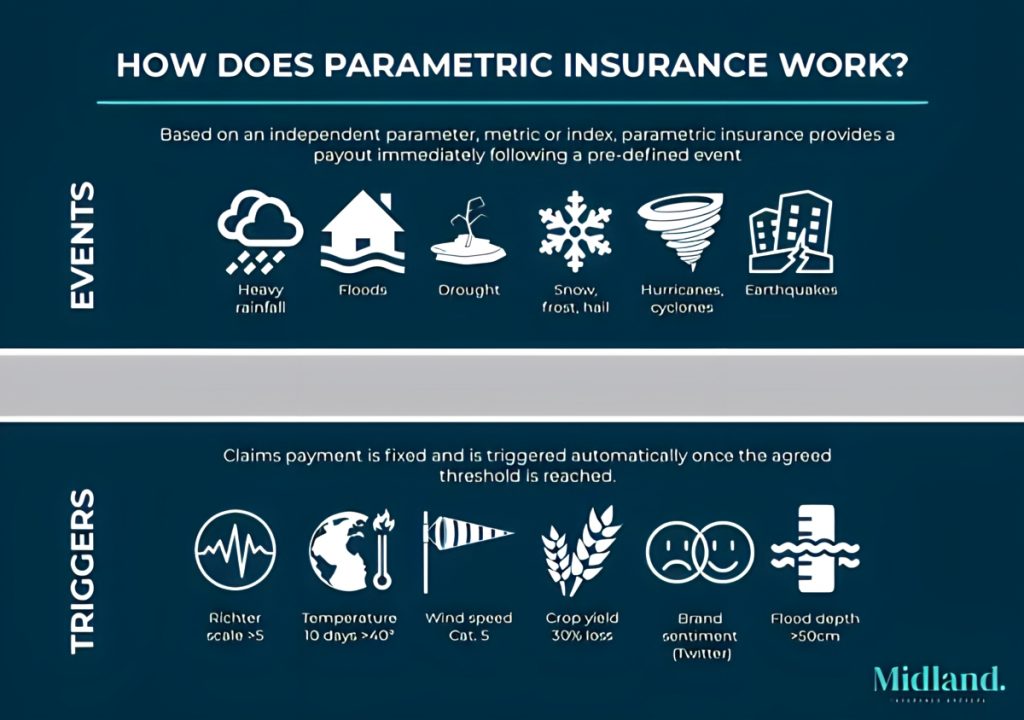Parametric Insurance: A New Wave in Risk Management for the Modern Era 2024

In the ever-evolving world of insurance, one term is making waves and catching the attention of businesses and policyholders alike: Parametric Insurance. Unlike traditional insurance models, parametric insurance offers a revolutionary approach that simplifies claims processes, reduces administrative burdens, and provides faster payouts.
This innovative insurance model hinges on predefined parameters and data triggers, allowing for a more efficient and transparent coverage mechanism. Whether you’re a business navigating the complexities of natural disasters or an individual seeking hassle-free insurance solutions, understanding parametric insurance could be your key to smarter risk management.
Dive in to explore how this cutting-edge concept can transform the way you think about insurance and financial protection.

Understanding Parametric Insurance: A Brief Overview
Parametric insurance represents a significant innovation in the insurance industry, particularly in how it manages risks associated with natural disasters and other predefined events.
Unlike traditional insurance, which compensates based on assessed damages, parametric insurance provides payouts based on predefined triggers, such as the occurrence of a hurricane with wind speeds over a certain threshold or a specified amount of rainfall during a set period.
This model allows for faster claims processing and payment, which can be crucial for rapid recovery following a disaster.
How Parametric Insurance Works
Parametric insurance operates by setting predefined parameters or triggers that, when met, automatically initiate a payout. These triggers can include various measurable events like earthquakes, rainfall levels, or wind speeds.
The policyholder and the insurer agree upon these parameters at the outset. When an event meeting these criteria occurs, the payout is processed without the need for a lengthy claims assessment. This process is often supported by advanced technologies such as blockchain, which ensures transparency and rapid execution.
Benefits of Parametric Insurance
Parametric insurance offers several advantages over traditional insurance:
- Speed of Payout: Since payouts are triggered automatically based on predefined events, funds are disbursed much faster, aiding quicker recovery.
- Reduced Administrative Costs: Eliminates the need for claims adjusters and lengthy assessments.
- Transparency: Clear parameters reduce disputes over claims, enhancing trust between insurers and insured parties.
- Coverage for Hard-to-Insure Risks: Effective for insuring against risks that are difficult to quantify or assess traditionally, such as extreme weather events and natural catastrophes.

Real-World Applications of Parametric Insurance
Parametric insurance has been successfully applied in various sectors. For example, in agriculture, farmers can protect themselves against drought by purchasing policies that pay out when rainfall falls below a certain level. In tourism, businesses can cover losses from events like hurricanes that disrupt travel plans. Governments and organizations also use parametric insurance to manage risks associated with natural disasters, providing quick funds for disaster response and recovery.
- Agriculture: Protects farmers against adverse weather conditions like droughts or excessive rainfall.
- Travel: Covers disruptions such as flight delays and cancellations due to extreme weather.
- Natural Disasters: Governments and businesses use it to manage the financial impact of hurricanes, earthquakes, and floods.

Emerging Trends in Parametric Insurance
The parametric insurance market is evolving rapidly, driven by advancements in data analytics and technology. The integration of AI and big data is enhancing the accuracy of parametric models, thereby reducing basis risk—the gap between the parametric trigger and actual losses. There is also a growing interest in parametric solutions for new types of risks, such as cyber attacks and business interruptions due to pandemics.
- Integration with Technology: Increasing use of AI and big data to refine risk models and triggers.
- Expansion into New Areas: New policies are being developed for risks like cyber-attacks and pandemics.
- Increased Capital Influx: More investment from traditional insurers and reinsurers, highlighting growing confidence in parametric models.
Case Studies: Success Stories in Parametric Insurance
Several case studies highlight the success of parametric insurance. For instance, parametric flood insurance products have been developed to address gaps left by traditional insurance. These products provide quick payouts based on predefined water levels, helping communities recover faster from flood damage. Another example is the use of parametric policies in Caribbean countries, where governments receive rapid financial support following hurricanes, aiding in faster and more efficient disaster response.
- Hawaiian Coral Reefs: A parametric policy was developed to protect coral reefs, with payouts triggered by storm events, allowing for rapid restoration efforts.
- Crop Insurance in Africa: Parametric insurance schemes have been successfully implemented to protect farmers against drought, ensuring food security and stable incomes.

Challenges and Considerations
Despite its benefits, parametric insurance faces several challenges:
- Basis Risk: The risk that the payout does not perfectly match the actual loss experienced.
- Regulatory Uncertainty: Varying regulations across different regions can complicate implementation.
- Market Resistance: Traditional insurers may view parametric insurance as a threat to their business models.
- Complexity in Design: Creating accurate and reliable parametric models requires significant expertise and technological investment.
The Future of Parametric Insurance
The future looks promising for parametric insurance, with continued advancements in data analytics and AI expected to enhance the accuracy and reliability of these products. Additionally, as climate change increases the frequency and severity of natural disasters, the demand for efficient and rapid insurance solutions like parametric insurance is likely to grow. Collaborative efforts between insurers, regulators, and technology providers will be essential in overcoming current challenges and fully realizing the potential of parametric insurance.
By understanding and leveraging the benefits of parametric insurance, businesses and governments can better manage risks and enhance their resilience against future uncertainties.






